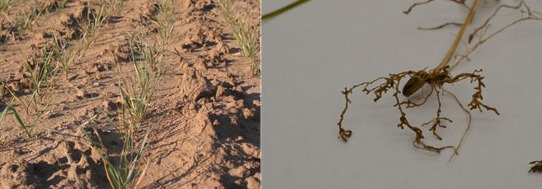Figure 1. Nitrogen deficiency on wheat. The lower leaves are the first to become chlorotic (yellow). Photo by Dorivar Ruiz Diaz, K-State Research and Extension.
Sulfur deficiency. Similar to nitrogen, the crop’s sulfur requirement increases in the spring as it takes off on reproductive growth. Due to a decrease in sulfur deposition in the rainfall, there has been an increasing number of fields with sulfur deficiency symptoms in Kansas in recent years. Deficiencies can be more common in areas where organic matter levels are low -- especially on sandier soils or eroded areas of a field. Sulfur deficiency can also occur where soils are cold in the spring due to a reduced rate of release of sulfur from organic matter. The symptoms of sulfur deficiency are very similar to nitrogen deficiency. However, sulfur deficiency differs from N deficiency in that the whole plant is pale, with a greater degree of chlorosis (yellowing of plant tissue) in the young/upper leaves (Figure 2). The pattern of chlorosis may show gradation in intensity with the younger leaves at the tip yellowing first because sulfur is not easily translocated within the plant. But the entire plant can quickly become totally chlorotic and take on a light yellow color. Symptoms often become more pronounced when plants begin growing rapidly while soil conditions are such that organic matter mineralization and sulfur release rates are low. Symptoms may disappear as the temperature warms up and moisture conditions improve, which increases the rate of mineralization of sulfur from organic matter and the rate of root growth

Figure 1. Nitrogen deficiency on wheat. The lower leaves are the first to become chlorotic (yellow). Photo by Dorivar Ruiz Diaz, K-State Research and Extension.
Sulfur deficiency. Similar to nitrogen, the crop’s sulfur requirement increases in the spring as it takes off on reproductive growth. Due to a decrease in sulfur deposition in the rainfall, there has been an increasing number of fields with sulfur deficiency symptoms in Kansas in recent years. Deficiencies can be more common in areas where organic matter levels are low -- especially on sandier soils or eroded areas of a field. Sulfur deficiency can also occur where soils are cold in the spring due to a reduced rate of release of sulfur from organic matter. The symptoms of sulfur deficiency are very similar to nitrogen deficiency. However, sulfur deficiency differs from N deficiency in that the whole plant is pale, with a greater degree of chlorosis (yellowing of plant tissue) in the young/upper leaves (Figure 2). The pattern of chlorosis may show gradation in intensity with the younger leaves at the tip yellowing first because sulfur is not easily translocated within the plant. But the entire plant can quickly become totally chlorotic and take on a light yellow color. Symptoms often become more pronounced when plants begin growing rapidly while soil conditions are such that organic matter mineralization and sulfur release rates are low. Symptoms may disappear as the temperature warms up and moisture conditions improve, which increases the rate of mineralization of sulfur from organic matter and the rate of root growth.

Source : ksu.edu